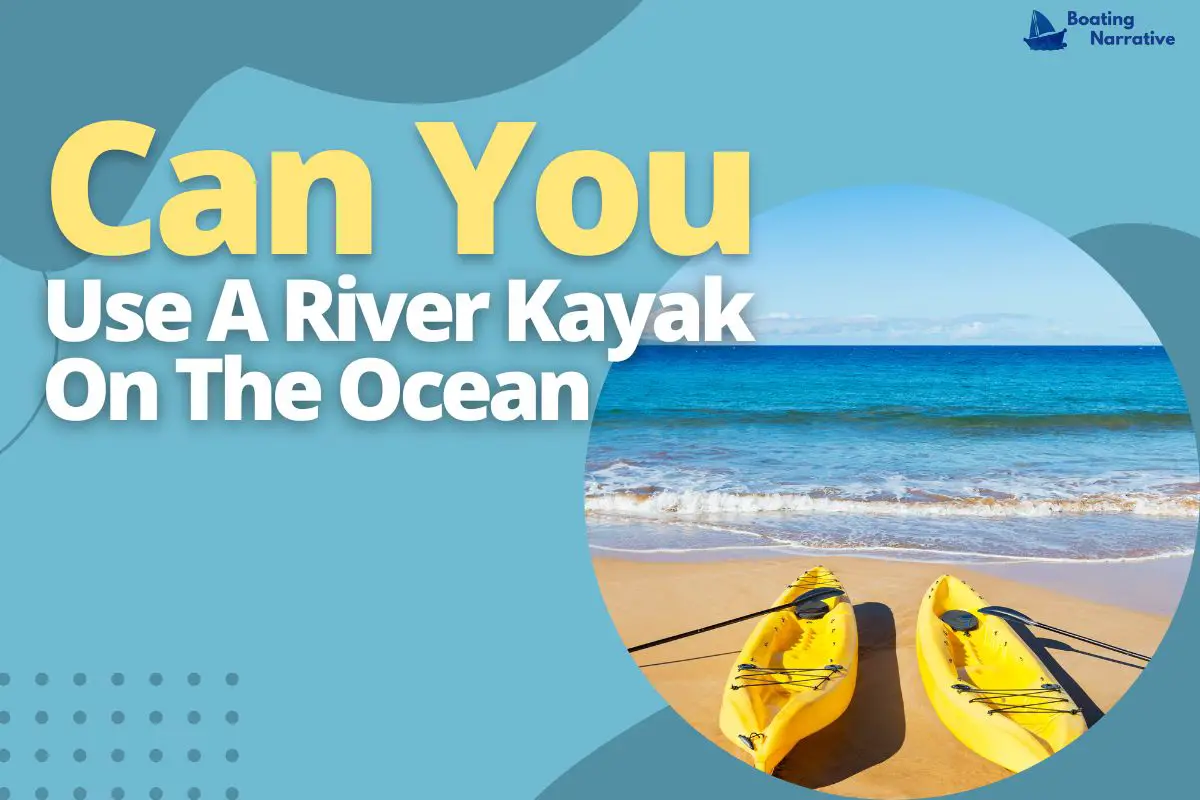Kayaking is a great way to explore a river or lake. But can you use a river kayak to paddle around in the ocean?
The short answer is yes. However, most people would tell you that it’s a bad idea.
The long answer is a little more complicated. This article will explain why river kayaks are a terrible idea for ocean kayaking and which kayak you should be looking for.
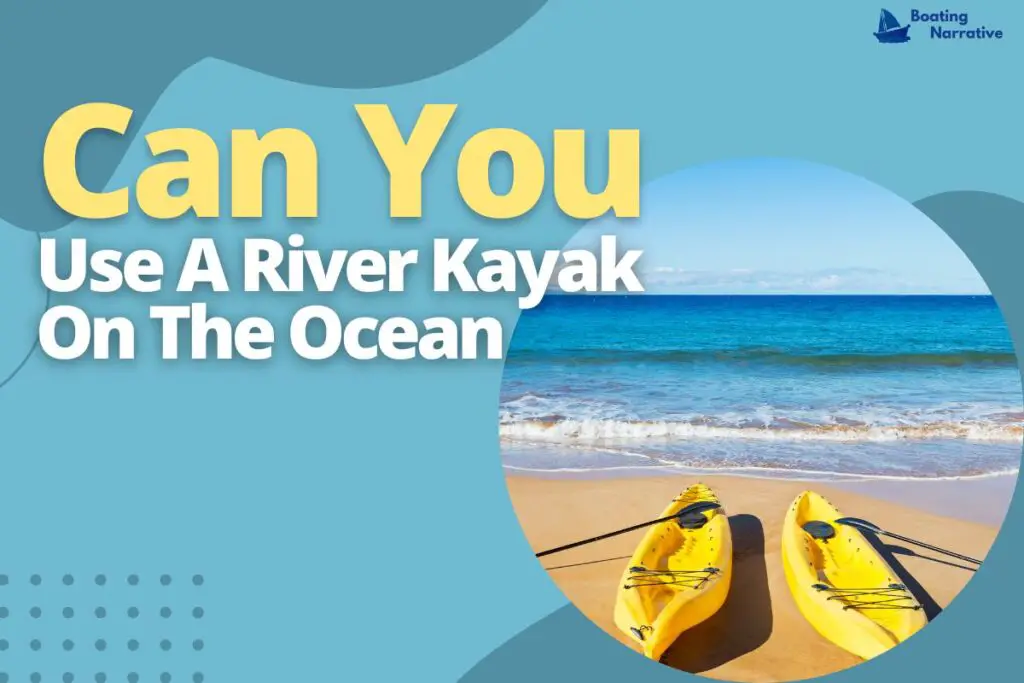
Here’s The Answer To Can You Use A River Kayak On The Ocean
Most river kayaks are not designed for use in the ocean. The main difference between river kayaks and sea kayaks is that river kayaks are not built to handle the rough conditions expected in the open ocean.
They are also not built to store as much gear, so ocean paddlers would be at a disadvantage if they tried to use a river kayak on the sea. That said, some river kayakers do choose to paddle in the ocean, and with the right kayak and some experience, it is possible to do so safely.
The main thing to keep in mind is that the water conditions in the ocean can be very different from those in a river, and kayakers need to be prepared for this.
Ocean waves, strong currents, and strong winds challenge kayakers, and rough conditions can make it difficult to maneuver or even capsize.
However, there are some things to consider if you plan on using your river kayak as an ocean kayak:
- Ocean-going kayaks are longer and narrower than those used in rivers and lakes.
- Ocean-going kayaks have bulkheads that keep water out of the hull if it becomes flooded (which doesn’t happen often), while river boats don’t have this feature.
- Ocean-going kayaks come with dry hatches so that all gear can be stored inside without getting wet.
Ocean Kayaks Are Longer And Narrower
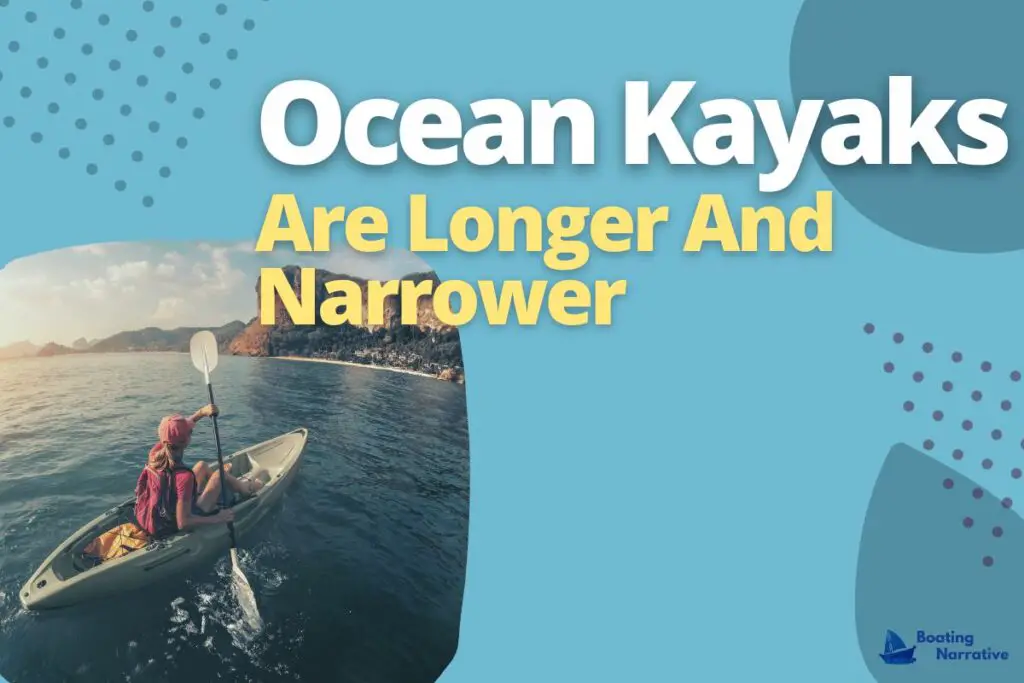
As you’ve probably figured out by now, ocean kayaks are longer and narrower than river kayaks. They’re designed for speed and performance, so they have a dagger-like shape that’s made to cut through water quickly.
River kayaks tend to be shorter and broader than ocean kayaks. They’re designed for stability and maneuverability, which makes them great boats for beginners who want something stable enough to get comfortable with before moving on to more advanced models.
Ocean kayaks are also built specifically for open water, and they don’t handle well in shallow rivers or creeks at all! If you’re looking for an adventure with some rapids on your agenda, then it might be better off just buy a separate boat altogether.
River Kayaks Are Wider
You may have noticed that river kayaks tend to be wider than ocean kayaks. This is because of the unique characteristics of rivers. Rivers can vary significantly in width, but they all share one thing: they’re shallow.
In addition to their constricted width, these waterways are frequently littered with debris like pebbles that can obstruct your path or even sink your boat if you hit them at high speeds.
To cope with these variable conditions, a river kayak needs to be wider so it has more stability when navigating through rocky rapids and shallow waters.
Ocean Kayaks Have Bulkheads and Dry Hatches
Bulkheads are the watertight compartments of the kayak, and they’re usually found in tandem with the cockpit at one end of your boat.
A dry hatch is a sealed storage compartment that protects from water so it doesn’t seep into the main hull of your boat.
This type of storage compartment is often used for storing food or equipment you need access to during long trips out on the water.
Bulkheads and dry hatches have pros and cons, but they can come in handy when crossing oceans in your kayak.
The Pros And Cons Of Using A River Kayak On The Ocean
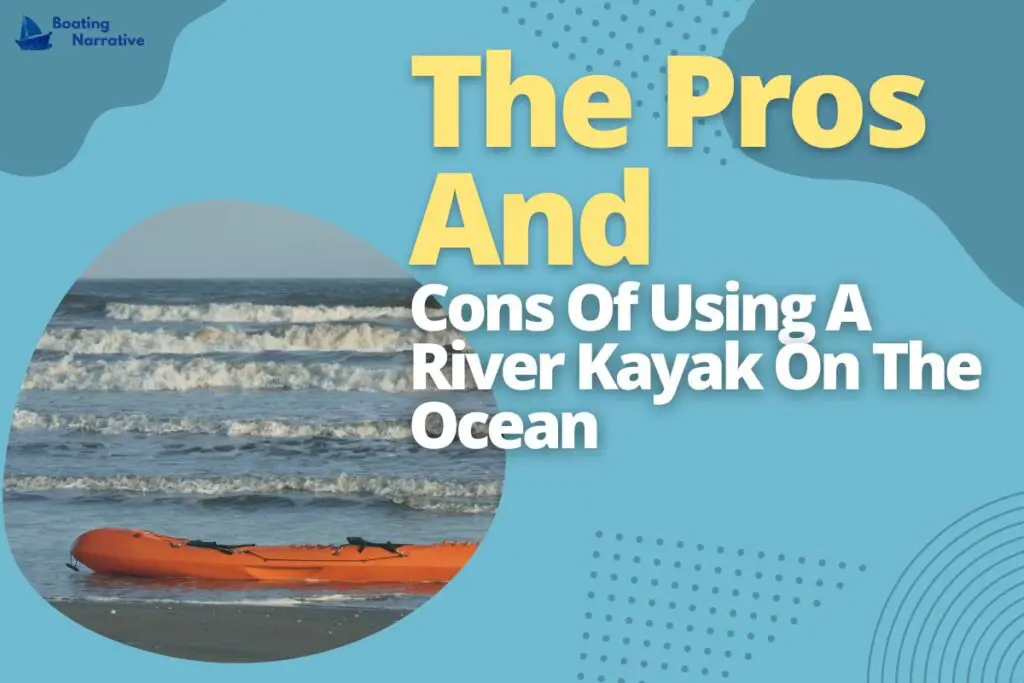
The pros of using a river kayak on the ocean are many. They’re more stable so that you won’t flip over as easily. They’re also more maneuverable, making them great for paddling in small spaces and tight corners.
Riverboats roll easier than other kayaks because they have a more rounded hull design, making them easy to roll up when needed.
River kayaks are also stronger and more durable than their sea-going counterparts because they are made with thicker plastic or fiberglass materials that can withstand harsher conditions like rapids or shallow water where rocks could damage the bottom of your boat.
River boats will cost less than their sea-going cousins, too, you’ll save money on the cost of buying your device (versus renting one), and you’ll have fewer repair costs over time because river boats tend to be lighter duty than their ocean equivalents (such as inflatable rafts).
Finally, if you’re looking for versatility, river boats offer plenty of options regarding what type/size boat suits your needs best: inflatable vs. hardshell; sit-on-top vs. cockpit; single seater vs. tandem.
Training Required
You need to hone your skills before taking on the open sea. Some people require training, whether it be boating or scuba diving, which is required by law.
In many locations, kayaking is not allowed unless you have completed a certification course and/or have been certified by an instructor.
This can range from being able to paddle safely in calm waters to surfing or paddling in hazardous conditions like storm surges and white caps (as seen during hurricanes).
In addition to training being required for specific conditions and activities (such as surfing), it is also recommended for many others.
Taking lessons is a good idea if you want to avoid injuries and improve your paddling skills if you plan to undertake any paddling involving rapids or whitewater.
Versatility
A river kayak’s versatility is why these boats are so popular. They can be used for fishing and diving, photography, racing, touring, and even kayaking if you want to modify your boat.
The larger cockpit makes them more comfortable than traditional sea kayaks as well. The larger cockpit allows you to move around in the boat without getting wet or feeling claustrophobic during longer journeys.
Maneuverability
While ocean kayaks are excellent in their own right, they can’t match river kayaks’ maneuverability. This is because river kayaks typically have more rocker and are less sheer than ocean kayaks.
These features make it easier to turn and respond quickly in the water. Because of this agility, rivers are a great place for beginners to learn how to paddle a boat before heading out into open water.
River kayaks also tend to be much more stable than ocean boats because their wider hulls distribute weight better across the bottom of your vessel, providing even more stability than what you’d find on land-based touring vessels (e.g., recreational sit-on-tops).
Rollability
When it comes to rollability, you’re going to have a lot of options. Many prefer the ocean because it offers more room for error than your typical river kayak.
To begin, three distinct roles may be used in a given situation:
- The traditional bow-in roll: You can correct yourself by doing a front flip from one side of the boat to the other while facing forward. This is usually used by beginners or those who want something easy and safe for their first time rolling. The downside? You have less control over your boat if you decide not to use this method (such as rough water).
- The bow-out roll: This technique works best when there are waves present but no windy conditions—meaning calm seas with plenty of space between them so that you can go through your motions properly without having anything get in your way. Make sure that someone else stands nearby just in case things go wrong; rapids aren’t precisely known as ‘calm’ since they tend not only to generate lots of current but also offer little room for error (especially if someone falls out!).
- Backward rolling/180-degree turn: For example, if something below deck were causing issues with how well certain parts were working, then this would probably be necessary since it allows them access without having too much difficulty getting around obstacles such as trees sticking out into surrounding rivers or streams – something which could cause significant problems during regular operation.
What To Expect When Using A River Kayak On The Ocean
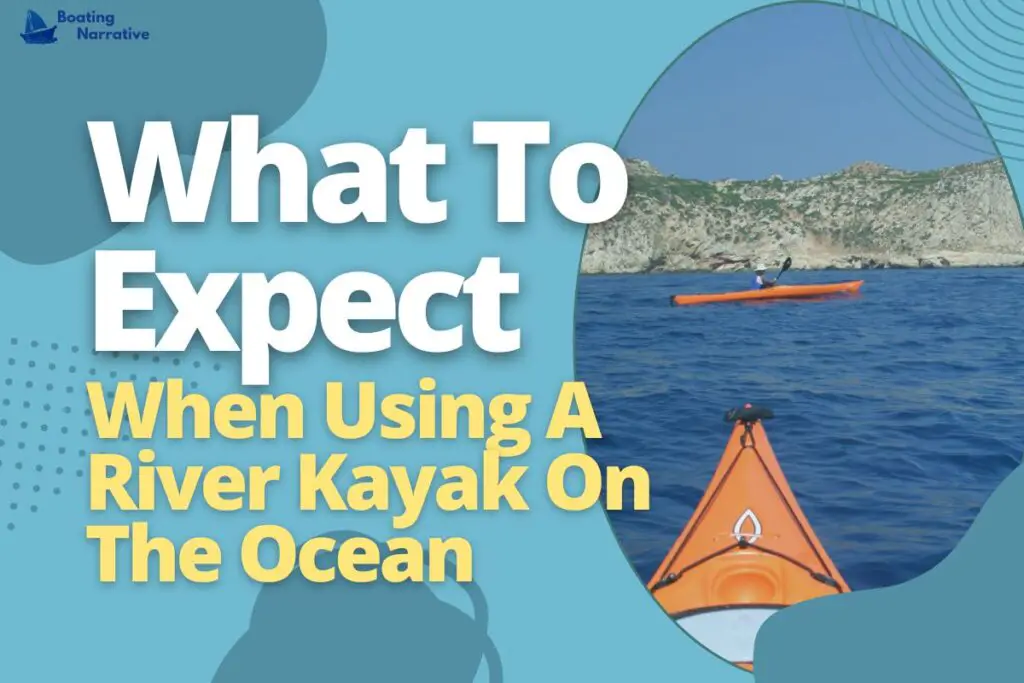
You can expect to get wet when you go out on the ocean in a kayak. You may be used to being wet when using a river kayak, but the ocean will not be as forgiving. Avoid falling in unless you want to wade through water up your thighs.
You also need to realize that if it’s windy enough for waves to form on the surface of the water, then it will be difficult (or impossible) for anyone in a kayak to paddle against them effectively enough for any significant amount of time.
In this situation, your best bet is to let yourself drift until things calm down before trying again to paddle against them.
In short: don’t try any dangerous maneuvers unless conditions are calm enough that they won’t put other people’s lives at risk as well as yours.
How To Prepare A River Kayak For The Ocean
Before you go out on the water, it’s important to check your kayak for any damage or wear. This is especially important when using a kayak you have borrowed from a friend or rented.
Typically, most people don’t think about these things until after they are in the middle of their trip, but it’s better to be safe than sorry.
- Check for cracks and leaks in the hull. You can do this by looking at both sides of the kayak while holding a flashlight and shining it around. It may take several minutes before anything pops up, so give yourself some time here! Suppose any cracks show up in your flashlight beam. In that case, you should not use this particular vessel because it could sink very quickly if something breaks under pressure during an ocean adventure (like hitting rocks).
- Check for rust spots on metal parts such as screws or brackets that secure parts together with nuts/bolts, etcetera. These can weaken the structure’s overall strength over time, leaving gaps where water could penetrate through holes which might cause problems later down the road when using the boat itself.
Safety Precautions When Using A River Kayak On The Ocean

Some essential safety precautions must be considered when paddling a river kayak on the ocean. The main difference between river kayaking and sea kayaking is the water conditions.
Ocean waves and strong currents can be much more challenging to navigate than calm waters. Additionally, weather conditions can be more extreme on the ocean, with strong wind and rough conditions.
A river kayak may not be sturdy enough to withstand large waves, and a sea kayak may not have the maneuverability to navigate choppy water. Having the proper paddling skills and stamina for ocean conditions is also essential.
Some other safety considerations for ocean kayaking include wearing a life jacket and having a buoyancy aid, as well as being aware of the risks of capsizing and being pulled out to sea by strong currents. It is also essential to have a rudder or skeg on your kayak to help steer in strong winds.
Conclusion
This blog post has outlined everything you need to know about using an ocean kayak.
Know that your intended use environment will determine the sort of kayak you choose. For example, you can use a river kayak in an urban environment and a sea kayak in a natural environment.
If you’re planning on kayaking on the ocean, the ocean kayak is the best product to use. However, ocean kayaks are heavy and are expensive to repair and maintain.
Not to mention, they take a while to learn how to use, and you will need to know how to paddle, maneuver, and avoid ocean hazards. To learn more, be sure to check out our website for more information on ocean kayaks.
Thanks for reading this blog post. For more great content, check out our other blog posts and keep following us for new topic updates.

